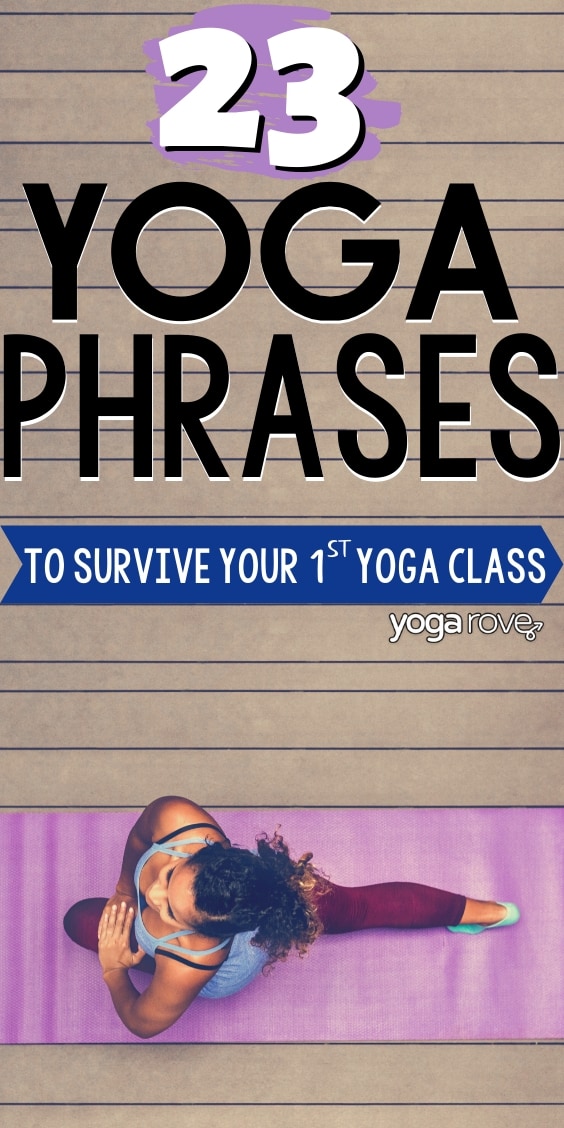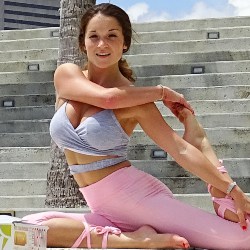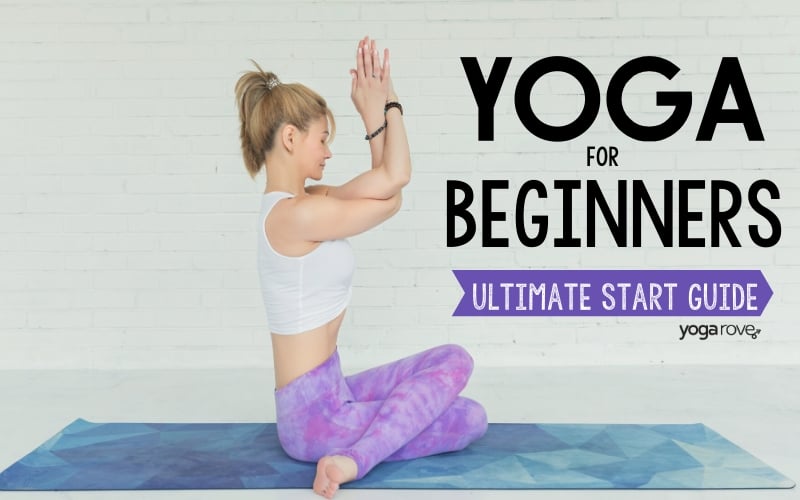This post may contain affiliate links. Please read our disclosure for more info.
Yoga can feel like a foreign language – technically, many of the words are, since yoga was established in the Sanskrit language. But even the English yoga phrases seems foreign – “sun salutation” – am I saluting the sun? “Tuck the stomach in” – is my belly hanging out?

Following instruction can be pretty difficult when it’s in a language that you don’t understand, so here’s a crash course in yoga vocabulary. It’s a quick breakdown of the most common words and yoga phrases to help you survive your first few yoga classes.
Background Words
These are “root” words of yoga. You may commonly hear them used by an instructor during an intro to a class, or during your practice to help guide you.
1. Yoga
This translates to “yoke” or “union” – it means to unite the mind, body, and breathing. Your entire practice’s purpose is unity of this triad.
A yogi is anyone who practices yoga, regardless of experience.
2. Yamas (and niyamas)
The ethical principles that guide the practice of yoga. The yamas are the controls over behavior you exhibit toward/around other people, and the niyamas are the self-disciplines. Basically, yamas are the principles of behavior that apply to your surroundings, and niyamas are the principles that apply to your inner world.
Yamas: nonviolence, truthfulness, non-stealing, non-excess, non-greed.
Niyamas: purity, contentment, self-discipline, introspection, surrender
3. Mantra
A phrase, word, or sound that can be repeated silently or out loud. Some teachers will use a mantra, or suggest a mantra for use, at the beginning of class, which will often be in the Sanskrit language and translated to English. This mantra can hold emotional, mental, or spiritual significance.
Examples of mantras:
- “I am love”
- “I am enough”
- “I am light”
- Om: this mantra is commonly chanted at the beginning and end of yoga class – it’s the universal sound of consciousness and has no religious connotation whatsoever. It’s said to be the seed of all sounds.
- Shanti: means peace. Often chanted after “Om” three times: “om shanti shanti shanti”
Note: if you feel uncomfortable chanting “om” or “shanti” at the beginning/opening of classes, you do not have to. Nobody will be insulted, or mind, if you don’t voice your mantra out loud ????
4. Namaste
Translates roughly to “the light within me honors the light within you;” it’s both a greeting and a farewell, but it most commonly said at the end of yoga class: after sitting up from Savasana, you’ll like sit in easy pose, then bow the head and say “namaste.”
5. Drishti
A focal point, most commonly used in balancing postures. You’ll often hear “establish a drishti directly in front of you” – that just means to find a non-moving object (AKA not your own reflection in the mirror) in front of you to stare at while you try to balance.
6. Mudra
A hand position that facilitates the flow of energy (prana) in the body. The most common mudras will have the thumb and middle finger or pointer finger touching. Unless the teacher is instructing you on how to use a specific mudra, don’t even worry about them.
Energy Body
These terms all refer to different things regarding your energy body, meaning your mind and soul. You can find these terms being used in any class, especially one involving meditation or that focuses highly on yogic philosophy.
7. Prana
Sanskrit for “vital life force,” prana is the energy that flows through your body, just as blood flows through the veins and arteries in the body. Prana is the energy that is managed by your chakras and bandhas.
8. Pranayama
Breathing exercises that clear the emotional and physiological obstacles in your body so that the prana can flow freely. Common pranayama exercises are single-nostril breathing and lion’s breath.
9. Ujjayi
Technically this is a type of pranayama. Ujjayi is the type of strong breathing that’s done with the mouth closed, inhaling and exhaling only through the nostrils. The sound/feeling is as though you’re trying to fog up a mirror with your breath, but your mouth is closed, so instead the air travels through the back of the throat and out of your nostrils, making a sound similar to the ocean waves as it travels through your throat.
10. Lion’s Breath
Similar to ujjayi breathing, but you will stick your tongue out and let the breath release out of your mouth. You may feel silly the first time you’re asked to do this, because it’s new and uncomfortable, but don’t worry – everyone else is doing it, too!
11. Chakra
The energy centers throughout the body. There are 7, and each is associated with a color and feeling. Your teacher will sometimes say “this will engage, or release energy from, your x chakra” – this is purely informational and if it makes no sense, you can completely ignore it!
12. Bhanda
Similar to the chakra energy centers, but these are physical muscle centers that you do physically engage. If they don’t make any sense during your practice, don’t fret too much, since it’s an internal muscle feeling – not an external position.
Bhandas are muscle “locks” that support the engagement and toning of certain muscles in poses through isolation and constriction.
There are 3 main bhandas your yoga teacher will refer to:
- Mula bandha: your pelvic floor muscles. When the teacher says to engage your mula bandha, think of activating the muscles that keep you from peeing your pants.
- Uddiyana bandha: an upward abdominal lift. When the teacher says to engage your uddiyana bandha, you will exhale completely and “lift” the diaphragm upward into the chest cavity.
- Jalandhara bandha: the throat lock. When you engage your jalandhara bandha, you will tuck your chin to your chest, aiming to touch the chin to the collarbones.
Common Physical Yoga Terms
The following phrases all refer to terms used during your yoga practice that have to do with your physical body. Many of these are poses that teachers commonly use the sankrit name for.
13. Asana
The physical postures practiced in yoga.
14. Vinyasa
Translates to “movement with breath,” but is also used to refer to a link of postures, specifically the flow between Sun Salutations.
If an instructor says “flow through your Vinyasa” after a standing pose, he/she is referring to: step back into Plank, lower through Chaturanga, raise to Upward Dog or Cobra, lift to Downward Facing Dog, and then step to the front of the mat for Tadasana.
15. Easy Pose
Basically criss-cross apple sauce position. If you have tight hips, you’ll sit on a block.
16. Child’s Pose
The pose that you can return to at any time in any yoga class if you are feeling like you need a break. You’ll kneel on your shins, then walk your hands forward, folding over your legs, so your forehead rests on the mat
17. Sun Salutation
A combination of 10-12 asanas linked together. The 2 common Sun Salutations you’ll encounter in most yoga flow classes are:
Sun Salutation A (surya namaskar A):
- begin standing with your hands overhead and fold forward
- lift the chest with a flat back to look forward and fold forward
- place hands on the mat and step back to plank
- lower through to chaturanga
- lift to upward facing dog or cobra
- lift the hips upward to downward facing dog
- hop or jump the feet to the front of the mat
- lift the chest with a flat back
- fold forward
- rise to standing, hands overhead.
Sun Salutation B (surya namaskar B):
- begin standing
- bend the knees to enter chair pose
- fold forward, straightening the legs
- lift the chest with a flat back to look forward
- fold forward, place hands on the mat
- step back to plank
- lower through chaturanga
- lift to upward facing dog or cobra
- lift the hips upward to downward facing dog
- step the right foot forward into Warrior I
- place both hands on the mat in front of you
- step or jump back to plank
- repeat cycle on 2nd side
- hop or jump the feet to the front of the mat
- lift the chest with a flat back
- fold forward à rise to standing, hands overhead
If all of that seemed like total gibberish, we’ll break down the Sun Salutation poses here:
- Tadasana/ Mountain Pose: stand at the front of your mat, shoulders away from the ears, palms facing forward. Your feet are parallel, so your big toes are touching but there is a 2-3 inches between your heels.
- Uttanasana/ Standing Forward Bend: fold forward, aiming to bring your hands to the mat. If you have tight hamstrings, lower back pain, or difficulty touching the ground, keep a slight bend in the knees.
- Adho Mukha Svanasana /Downward Facing Dog: to achieve proper alignment in your Downward Dog, enter it straight from plank by lifting your hips to the sky and pressing your quads back behind you. Your palms will be shoulder width, and your goal is to reach the heels to the mat with the legs straight – but it’s totally fine if the don’t. Let the head hang heavy – hold no tension in the neck.
Similar to forward fold, if you have lower back issues or tight hamstrings, keep a light bend in your knees.
- Chaturanga Dandasana (“chaturanga” for short): this is basically a yoga push-up; it’s how you’ll move from plank to upward dog. Unlike a standard yoga push-up, you keep your elbows tucked into your sides as you lower your body down to the floor.
- Cobra: a backbend that is often confused with Upward Facing Dog, this posture is different in that your legs and pelvis remain on the floor. You do lift your chest to open your heart, but there is a slight bend in your arms at the elbows as you lift.
- Upward Facing Dog: a backbend that lengthens the spine and arms. It is similar to Cobra pose in the way you enter the pose, but the arms will straighten all the way so that your legs and pelvis lift off the mat – only your palms and tops of your feet will be touching the mat.
*Note: it’s OK if you do Upward Dog when other people are doing Cobra, and visa versa. In yoga, these positions are generally “yogi’s choice” – unless the instructor is being very specific with instruction about doing Cobra or Upward Dog, do the backbend that feels right to you!
18. Warrior I, II, and III
These 3 poses are the foundational postures for most yoga classes, and will often be used throughout a Vinyasa flow:
Warrior I:
- Think hips and torso square to the front of the room (the most common error in this posture is allowing the back leg to pull the hip open)
- Your front foot is parallel to the side of your mat, toes pointing toward the front of the room.
- Your back foot is rotated slightly outward, so your toes are pointing toward the top corner of your mat, heel slightly inward.
- Your front leg is bent at 90 degrees: the knee should be directly over the ankle. If it’s further over the ankle, you need to widen your stance. If it’s behind your ankle, shorten your stance.
- Your back leg is completely straight, with the knife edge of your back foot pressing into the mat.
Hip alignment: Bring your hands to your hips and notice where they are in space – if they are square, you’re good. If they’re not, shift them so they are. If you have difficulty doing this, step the back foot outward a bit.
- Bring the arms overhead, biceps in line with the ears.
- Gaze is directly in front of you.
Warrior II:
- Think hips and torso open; square to the side of the room.
- Your feet will be the same distance apart as in Warrior I, and your front leg and foot in the same position, but your back leg will be slightly different:
- Your back foot is now parallel to the back edge of your mat, so the toes point toward the side of the room, and your front heel will line up with the middle of your back foot.
- Your front leg is bent at a 90 degree angle, with your back leg straight.
- Extend the arms outward, parallel to the floor: your front hand will reach toward the front of the room; your back hand toward the back of the room.
- Gaze is directly in front of you.
Warrior III:
This posture is a strengthening and balancing asana, whereas the other 2 Warrior poses are strengthening and stretching. You will most often enter Warrior III from Warrior 1, lunge, or crescent lunge. In this posture, your torso and hips are square to the ground.
- Your standing leg’s foot will be parallel to the side edge of your mat, toes pointing to the front of the room.
- Hands at heart’s center, fold forward so that your torso is parallel to the floor.
- The back leg lifts off of the mat, knee and toes point toward the floor (your leg is rotating slightly inward). The back foot is flexed as if you’re pressing into a wall behind you.
- The crown of your head to the heel is one straight line.
Hip alignment: bring the hands to the hips – are they square to the ground? Is your back leg pulling your hip outward instead of staying square?
- Gaze is directly at the ground in front of you – do not strain the neck, but do not allow it to drop. Instead, feel as though someone is literally pulling your neck forward form the front, and your back heel backward from behind you.
19. Savasana
Corpse pose: the sweet surrender at the end of a yoga class. This is the time when the lights are dimmed and you lie down flat on your mat, feet mat-width (or wider) apart, arms by your sides, with palms facing upward. Your eyes will close, and you will focus on reaching a deep, meditative state.
*Note: it’s considered very rude to leave a class during savasana. If there are time constraints that make you need to leave early, be sure to advise your teacher before class starts, and cut out of class prior to the start of savasana.
Alignment Cues
These are all cues your instructor may say during your practice to bring awareness to certain parts of your body in specific poses.
20. Tuck the Pelvis
This means, basically, don’t stick your booty out. Don’t allow your lower back to arch. Instead, engage the core and pelvic muscles to pull the lower spine in line with the upper spine.
21. Shoulder Blades Away from the Ears
You’d be surprised at how often your shoulders creep up to your ears – they are the body’s immediate reaction to stress and unfamiliarity. Your shoulder will say this often in poses from standing Mountain to Upward Dog – visualize your shoulder blades gliding down your back and away from your ears, allowing for space in the neck.
22. Spread the Fingers Wide
Whether in Plank, Downward Dog, or any other position where your palms are on the mat, you’ll want to spread the fingers wide and distribute the weight evenly throughout the hand – spreading your fingers allows for this equal distribution.
23. Lift Your Tailbone
Usually said in Downward Dog and Forward Fold, this generally is a cue to lengthen your hamstrings and create space in your lower back so that the tailbone “lifts” higher in space
Do you feel ready to tackle your yoga classes now? Think of this guide like the language on the signs of your yoga path that you can follow. After all, yoga is not about the pose – it’s about your journey!
We hope that you use these tools to make your yogic path a little easier to navigate – like any journey into the unknown, you’ll pick up new tips, tricks, and vocabulary along the way.
If you’re looking where to get started to practice yoga at home, check out our Free Resource Library for free yoga printables!
Previously a dancer, Ashley has been practicing yoga for over 15 years and teaching for 5.
She balances an executive-level “corporate” position during the day with healthy, mindful wellness practices in her free time to stay grounded; she lives on celery juice and cold brew, and can’t live without her dark chocolate!







Thank you, this was very helpful
You’re very welcome 🙂
Thanks , I have found this information very helpful and the way it’s been presented is easy to relate to.
Absolutely! I’m glad you found it useful! 🙂
Thanks so much Ashley!